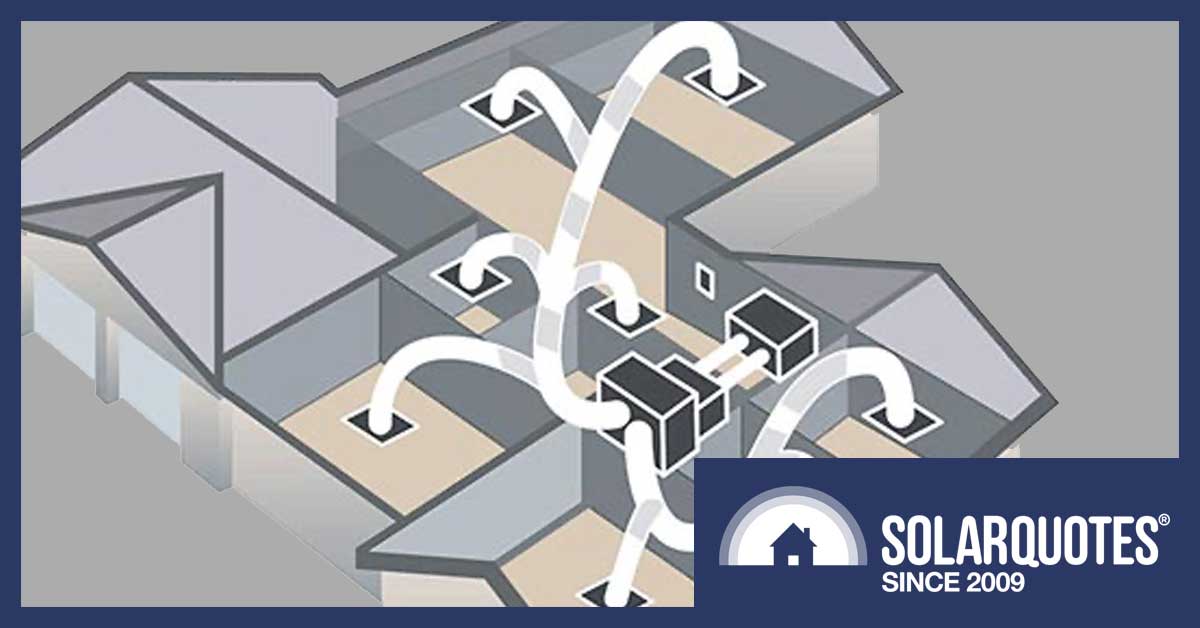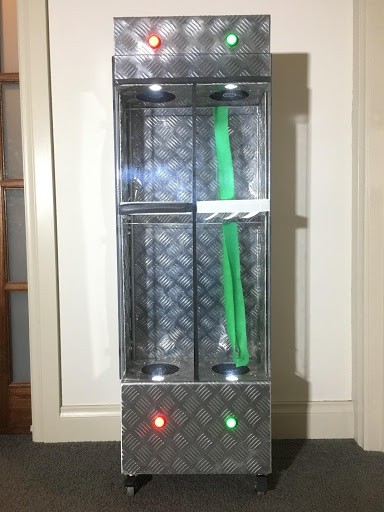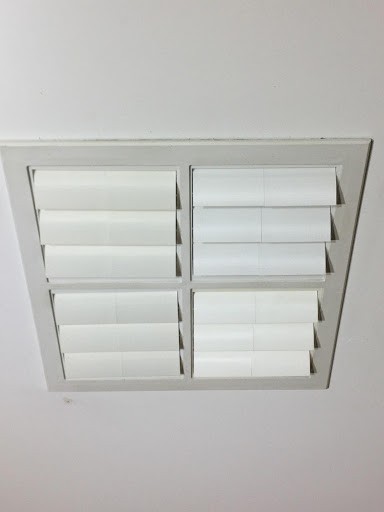
A big problem with ducted air-conditioning is the ducts compromise the thermal envelope of the room, wasting precious energy. A new Australian invention solves that problem.
An asthma attack following a child’s night-time popcorn mishap set Adelaide engineer Dean McGurgan wondering why, in his ducted-aircon-equipped home, he even copped smoke exposure all the way from the kitchen to the bedroom.
And that set him on a development project he reckons could save money for others with ducted air-conditioning.
How? Because it became clear to McGurgan the baffles meant to divide a home into different zones don’t work particularly well, especially when off. Such leakage might not matter much in summer if you own both solar panels and an air-conditioner, because if there’s an excess of solar power, who cares about optimal efficiency?

The vent, in the airflow demonstration cabinet McGurgan built for the Flinders University startup program. It shows how the vents automatically open and close as the air-conditioner starts and stops.
In winter however, when the power from rooftop solar is at its lowest and the risk of needing to import electricity from the grid greatest, McGurgan reckons leakage matters. So he set about designing an automatic louvre system that does well what baffles do badly – isolate different zones from each other.
And where he’s at after more than three year’s work is a working unit he hopes someone will want to license for manufacture, because in his home tests, McGurgan told SolarQuotes he believes it would pay for itself in a little over three years.
If the burned popcorn was the lightbulb-moment that made McGurgan realise baffles in ducted systems don’t seal particularly well, what gave the project a personal urgency was watching his elderly father balancing on a ladder to put plastic over vents, because that’s where heated air was leaking to in winter:
“all of our hottest air bleeds straight into our ceiling vents and ductwork”.
“Awesome To Watch”
The idea is simple enough: what McGurgan calls the “Anti-Gravity Ceiling Vent” would be built as a drop-in replacement for standard aircon four-outlet vent sizes (with spacer plates available for other sizes). It’s self-installable since neither power or plumbing are required, and it’s already won a People’s Choice Award under Flinders University’s Venture Dorm startup program.
While coy about what he called the “secret sauce”, McGurgan told us the provisionally-patented vent is activated by airflow – there are no batteries, no wiring, and no apps.
“It’s awesome to watch – when you turn the aircon on, they’re all open.” As time passes, the vent responds to airflow and closes its blades to keep the conditioned air in place.
“The aircon used to turn on every eight minutes,” McGurgan said. “After I put the vents in, that went to every 13 minutes.”
Where does he get his cost-and-recovery estimate?
McGurgan told us in manufacture, the vent would cost between $25 and $35 – with four vents per outlet, that’s $100 to $140. In a house with nine outlets (for example, four bedrooms, multiple bathrooms, and common areas like kitchen and family room) the total cost would be $900 to $1,200.
He told SolarQuotes “the average house in Australia spends about $1,800 a year on heating.”
When he measured his system with USB thermostats on each vent, he observed a 15-20% improvement in efficiency. That equates to more than $270 per year, so if the manufacturer can keep the cost down, the outlay could be recovered in a bit over three years.
And we’re beyond “he reckons it works”: in August, McGurgan said the product received an airflow and analysis validation from Melbourne-based NATA laboratory Vipac.
Ready To Licence
And that’s why he’s ready to attract a manufacturer’s eye.
“If every Bunnings store sold to just one household in Australia per day, that would be $300k of retail sales per day,” he said.
“I’m at the point where I’ve developed it, tested in my own house, $5,500 on testing — I have a certificate that [it] works, so I’m looking to licence it. That’s the hardest part – you have to work full time just to get interest!”
He pointed out to SolarQuotes that while there are individually-controllable vents (and of course, apps to control them), self-install isn’t really an option if you need electrical wiring and solenoids.
Dean can be contacted here.


 RSS - Posts
RSS - Posts



I for one am sick of sealing my evaporative cooler vents after summer, trying to work out when to mothball the system in prep for winter. Too late and we can’t turn on the (separate) gas ducted heating or too early and we cant use the cooler.
Electrically controlled dampers are the way to go…. except for the exorbitant cost.
Cant wait to see these in manufacture.
Hi Steve.
Yes it has been a long road.
Hopefully it becomes another Australian iconic product derived out of necessity, from the Aussie backyard shed.
Stay tuned,
Dean
Hi Dean. Did these ever get into production?
Hi Dean am interested in this, any update on purchases of this?
If you look at some of the innovative retail tariffs on offer in SA (see IOenergy.com.au for some examples) then the real value of using less power for air-conditioning becomes apparent. That 3 year pay-back will fall to a fraction of time. Put simply, you could easily double the single rate price, if not triple it for the benefits for summer peak power being reduced.
I hope this innovation comes through.
Is there a solution for the side-wall vents as well?
ps I am not associated with IOenergy, and am not recommending them per se. But the offers are really innovative and reflect the underlying costs (and potential benefits from avoidance) hidden by simple tariffs.
Even better would be to replace the systems with split system reverse cycle air conditioning. Using multi-head sytem or multiple system to do away with ducts altogether.
Much more efficient and much less leakage through the duct-work.
So is this an upside down version of those Draft-Stoppa devices you put over your ceiling exhaust fans? (but built into an airtight vent housing)
Its a great idea. It certainly addresses the main inefficiency with ducted heating and cooling. I’m very surprised it’s not an option that all duct manufacturers already have. Well done that inventor.
I went to the trouble of cutting some “blanks” out of white MDF and twice a year swapped vents for blanks and vice versa. Worked very well for an evap cooling system but about a half hour job for a big house. Can’t believe no one wants to manufacture this new simple idea. Unfortunately it will probably end up in manufacture in China.
Well done to Solar Quotes for trying to assist.
Hi Robin
Yes I hope Australian industry gets behind my product first.
Good effort in blocking your vents, pretty dangerous as well, I hope you don’t have 12 foot ceilings!
Thanks for your support.
Stay tuned,
Stay safe,
Dean
fantastic invention
simplicity is always a great outcome
Im ready to buy a set!
Great solution. Any progress on when might be available? I’m in Adelaide if you need another test site! Happy to pay for it ?
our high ceilings plus the a/c vents means heat is rising up there and not down where I am. This invention is what we need NOW with electricity costs rising and one of the coldest winters I’ve known in Adelaide. please someone make it happen so I can purchase.
All of my duct vents are round and I’d really like to get these, but they appear only to be for square vents. I remember my builder asking me whether I prefer round or square and i am kinda upset/annoyed that I didn’t say square.
anyone know if these ever got manufactured. looking for exactly this kind of solution.